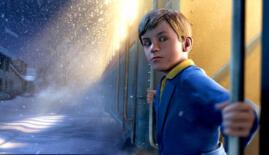The Polar Express warms hearts, distracts minds
review by matthew webber
 For the second holiday season in a row, Hollywood has adapted a picture book into a full-length feature film. Uh-oh. As almost anyone who treasured reading Dr. Seuss as a parent or child can attest, last year’s Mike Myers’ vehicle The Cat in the Hat was a candy-colored, potty-humorous, flaming sack of coal.
For the second holiday season in a row, Hollywood has adapted a picture book into a full-length feature film. Uh-oh. As almost anyone who treasured reading Dr. Seuss as a parent or child can attest, last year’s Mike Myers’ vehicle The Cat in the Hat was a candy-colored, potty-humorous, flaming sack of coal.
Luckily for moviegoers, the producers of the adaptation of Chris Van Allsburg’s Caldecott Award-winning perennial The Polar Express actually seem to have read and respected the book. The only thing keeping this film from being equally classic is that the filmmakers may have respected it too much. True, the film is a loyal adaptation of the book – so much so it doesn’t dare to be as magical. Plot- and character-wise, this film is safe in every way.
This quibble, however, shouldn’t keep the film from becoming a new yearly ritual for families. The film should easily be remembered as this year’s most successful Christmas film. After all, it’s either this, another Tim Allen vehicle, or a Surviving Christmas few paying customers seem to have survived.
Kids and adults both will relate to the conflict in The Polar Express between a 10-year-old boy’s gnawing doubts about the existence of Santa Claus and his growing certainty that he wants to hold on to the exuberance he has always felt upon waking up to a warm house full of loved ones and presents on Christmas morning.
The unnamed boy goes to bed on Christmas Eve a doubter, but when a North Pole-bound train pulls up to his window and the conductor tells him to step aboard, he begins a night-long journey to re-learn the magic of Christmas. Along the way, he makes new friends, meets the elves, and receives a special gift. Really, it’s the same journey most of us took in our dreams every Christmas Eve back when we believed in Santa Claus, back when visions of sugarplums danced in even our parents’ heads.
The message of The Polar Express is obvious before it even begins, which doesn’t make it invalid. Unless you’re a professional critic, there’s nothing necessarily wrong with heartwarming works of art.
The most daring, but also most distracting, thing about The Polar Express is its realistic-looking animation. In this cartoon, Tom Hanks plays several characters, lending them not only his voice but also his movements and expressions through a process called “motion capture” that renders a real-life actor’s performance into a digital form. It’s the same process that brought The Lord of the Rings’ Gollum to life. Here, the technique works because it helps create a mise en scene as lush as Van Allsburg’s illustrations, and the people look as real as they can for being digital.
However, this heightened sense of reality calls attention to the fact it is not real, and my awareness of this unreality distracted me throughout the course of the film. My inability to completely succumb to the film’s world, to forget I was sitting in a theater, means The Polar Express is not the best cartoon of the year by a long shot, especially in a year of The Incredibles and Shrek 2.
But that doesn’t mean I can’t re-watch The Polar Express next Christmas.
Copyright (c) 2005 erasing clouds |
|